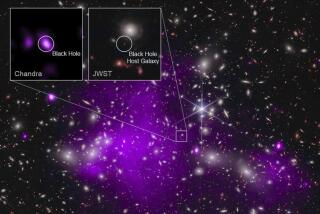Astronomers Discover Evidence of Massive, Unknown Object
- Share via
NEW YORK — Astronomers have found evidence of a mysterious object in space that could be the most massive known in the universe, but so far they can only guess at what it is, scientists said Tuesday.
The object apparently contains about 1,000 trillion times the mass of the sun, or 1,000 to 10,000 times the mass of the Milky Way galaxy, said Edwin L. Turner, professor of astrophysical sciences at Princeton University and one of the researchers who will report the finding this week in the British journal Nature.
Another scientist said the apparent characteristics of the object would make it an unprecedented discovery.
The object has not been seen, but its presence was shown by the effects of its gravity, Turner said. The tip-off came in studies of what is apparently a pair of quasars, starlike objects that can produce massive amounts of light and other radiation, about 5 billion light-years away. A light-year is the distance light can travel in a year, about 6 trillion miles.
Mix of Wavelengths
Starlight is a mix of various wavelengths of light, and it can be split into individual wavelengths to get a distinctive profile, sort of a celestial fingerprint, for various stars. When that was done for the light from the two quasars, Turner said, the profiles were “astonishingly similar.”
The quasars may be twins, but the similarity suggests they are in fact one quasar, Turner said. A quasar could appear as two if gravity from a massive object between it and Earth is acting like a lens, bending the quasar’s light so that duplicate images arrive at Earth, Turner said.
Half a dozen “gravitational lenses” have already been reported, but the effect of this one would be far more than that of the strongest lens known previously, suggesting that the mysterious object would probably be more than 400 times as massive, Turner said.
May Be New Type
If the new lens exists, it would have to be caused by the most massive object known in the universe, he said. The object could be of a type not yet known, he said.
The object would be an unprecedented discovery in terms of the amount of mass concentrated in a relatively small area to produce the observed effect, said J. Craig Wheeler, astronomy professor at the University of Texas, Austin.
The scientists have speculated that the object could be a cluster of galaxies; a black hole, which is a dark, dense concentration of matter with huge gravitational pull, or a cosmic string, which has never been seen but is thought to be thinner than an atom and potentially long enough to stretch across the known universe.






